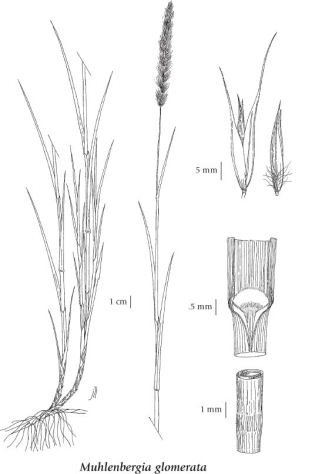Muhlenbergia glomerata (Willd.) Trin.
marsh muhly (spiked muhly)
Poaceae (Grass family)
Introduction to Vascular Plants
marsh muhly (spiked muhly)
Poaceae (Grass family)
Introduction to Vascular Plants
Species Information
General:
Perennial grass from scaly rhizomes; stems hollow, erect, slightly compressed, unbranched or sparingly branched, the internodes dull, finely short-hairy, 30-120 cm tall.
Leaves:
Sheaths minutely rough, slightly keeled, appressed-hairy at base; blades flat, 2-6 mm wide, 2-15 cm long, minutely rough or occasionally smooth; ligules membranous, jagged to more or less fringed with fine hairs, the tips squared-off, 0.2-0.6 mm long.
Flowers:
Inflorescence a narrow, condensed, spikelike, densely flowered, somewhat lobed panicle, 1.5-12 cm long, 0.3-1.8 cm wide, the branches tightly appressed, 0.2-2.5 cm long, the spikelets densely clustered; spikelets 1-flowered, nearly unstalked to short-stalked; glumes narrow, awl-pointed, 1-nerved, smooth to minutely rough near the tips, nearly equal, usually 1.3-2 times longer than the lemmas, (3) 4-7 (8) mm long, the tips long-pointed, tapering into short awns up to 5 mm long; lemmas lanceolate, 3-nerved, short soft-hairy along the midnerves, margins and at the base, minutely rough near the tips, 1.9-3.1 mm long, the tips long-pointed, unawned or short awn-tipped, the awns up to 1 mm long, minutely rough, the calluses bearded, the hairs short soft-hairy, about 1 mm long; paleas lanceolate, loosely soft-hairy between nerves, about the same length as the lemmas, the tips long-pointed; anthers about 0.8-1.5 mm long, yellowish.
Notes:
This species has been studied cytologically and most populations appear to be diploid (2n=20) whereas two close relatives, M. mexicana and M. racemosa, are tetraploids (2n=40). Separation of these taxa is often problematic and major differences are emphasized in the key.
Illustration

If more than one illustration is available for a species (e.g., separate illustrations were provided for two subspecies) then links to the separate images will be provided below. Note that individual subspecies or varietal illustrations are not always available.
Illustration Source: The Illustrated Flora of British Columbia
USDA Species Characteristics
Flower Colour:
Yellow
Blooming Period:
Late Spring
Fruit/Seed characteristics:
Colour: Brown
Present from Summer to Fall
Source: The USDA
Ecology
Ecological Framework for Muhlenbergia glomerata
The table below shows the species-specific information calculated from
original data (BEC database) provided by the BC Ministry of Forests and Range.
(Updated August, 2013)
The table below shows the species-specific information calculated from
original data (BEC database) provided by the BC Ministry of Forests and Range.
(Updated August, 2013)
| Site Information |
Value / Class |
||
|
Avg |
Min |
Max |
|
| Elevation
(metres) |
1025 | 850 | 1200 |
| Slope
Gradient (%) |
1 | 0 | 6 |
|
Aspect (degrees) |
285 | 270 | 300 |
| Soil
Moisture Regime (SMR) [0 - very xeric; 4 - mesic; 8 - hydric] |
6 | 4 | 7 |
| Modal
Nutrient Regime
Class |
D | ||
| #
of field plots species was recorded in: |
8 | ||
| Modal
BEC Zone Class |
SBPS | ||
|
All BEC Zones (# of stations/zone) species was recorded in |
ICH(2), IDF(2), SBPS(3) | ||
|
Source:
Klinkenberg 2013
|
|||
Habitat and Range
Wet to moist meadows, streambanks, bogs, irrigation ditches, lake margins, and hot springs in the steppe and montane zones; rare in BC east of the Coast-Cascade Mountains; N to NT, E to NF and S to ME, MA, PA, NC, KY, IL, IA, NE, CO, UT, NV and NE OR.Status Information
Synonyms
Synonyms and Alternate Names:
Muhlenbergia glomerata var. cinnoides (Link) F.J. Herm.
Muhlenbergia racemosa var. cinnoides (Link) Boivin